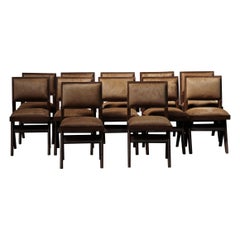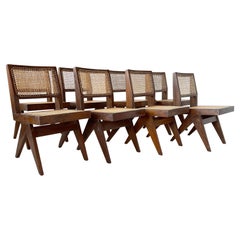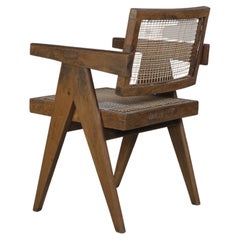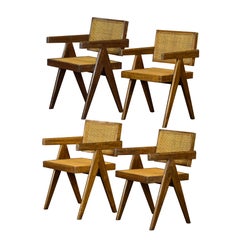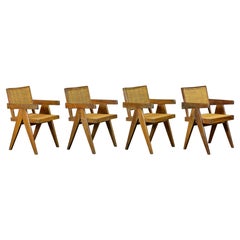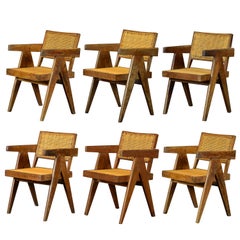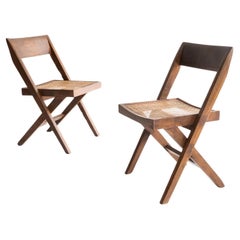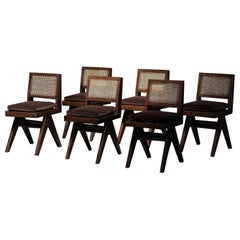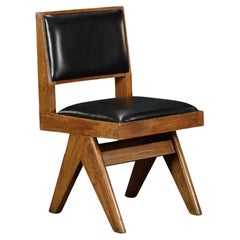Jeanerret Dining Chair
Vintage 1950s Indian Dining Room Chairs
Cowhide, Teak
Vintage 1950s Indian Mid-Century Modern Dining Room Chairs
Teak
Vintage 1950s Indian Mid-Century Modern Dining Room Chairs
Cane, Teak
Mid-20th Century Indian Mid-Century Modern Chairs
Cane, Teak
Vintage 1950s Indian Mid-Century Modern Armchairs
Cane, Teak
Mid-20th Century Indian Mid-Century Modern Chairs
Cane, Teak
Vintage 1960s Indian Modern Dining Room Chairs
Teak
20th Century Indian Dining Room Chairs
Velvet, Cane, Teak
Mid-20th Century Indian Mid-Century Modern Dining Room Chairs
Leather, Teak
Vintage 1950s Indian Mid-Century Modern Dining Room Chairs
Cane, Teak
Vintage 1950s Indian Mid-Century Modern Dining Room Chairs
Cane, Teak
Vintage 1950s Indian Mid-Century Modern Dining Room Chairs
Cane, Teak
20th Century Indian Mid-Century Modern Dining Room Chairs
Cane, Teak
Mid-20th Century French Dining Room Chairs
Wood
2010s Italian Mid-Century Modern Chairs
Fabric, Wood, Oak, Teak
Mid-20th Century Indian Mid-Century Modern Side Chairs
Faux Leather, Teak
Vintage 1950s Indian Mid-Century Modern Chairs
Teak, Cane, Wood
2010s Italian Mid-Century Modern Chairs
Cane, Wood
2010s Italian Mid-Century Modern Chairs
Cane, Wood
2010s Italian Mid-Century Modern Chairs
Wood
Vintage 1950s Indian Mid-Century Modern Office Chairs and Desk Chairs
Rattan, Teak
Mid-20th Century Indian Mid-Century Modern Dining Room Tables
Teak
2010s Italian Mid-Century Modern Chairs
Cane, Wood
2010s Italian Mid-Century Modern Chairs
Cane, Wood
2010s Italian Mid-Century Modern Chairs
Cane, Wood
2010s Italian Mid-Century Modern Chairs
Cane, Wood
2010s Italian Mid-Century Modern Dining Room Tables
Glass, Wood
2010s Italian Mid-Century Modern Chairs
Cane, Wood
2010s Italian Mid-Century Modern Chairs
Cane, Wood
2010s Italian Mid-Century Modern Dining Room Tables
Glass, Wood
2010s Italian Mid-Century Modern Dining Room Tables
Glass, Wood
Late 20th Century Dining Room Chairs
Oak
Vintage 1950s Indian Mid-Century Modern Office Chairs and Desk Chairs
Rattan, Teak
Vintage 1960s Belgian Brutalist Dining Room Chairs
Pine
Vintage 1970s Dutch Mid-Century Modern Dining Room Chairs
Oak
Vintage 1960s French Mid-Century Modern Dining Room Chairs
Straw, Wood
Vintage 1960s Indian Modern Dining Room Tables
Rosewood
Mid-20th Century French Mid-Century Modern Dining Room Chairs
Rope, Oak
Mid-20th Century Dutch Brutalist Chairs
Papercord, Wood
Vintage 1920s Italian Mid-Century Modern Chairs
Steel
Vintage 1970s Spanish Brutalist Dining Room Chairs
Bouclé, Oak
Mid-20th Century French Modern Dining Room Chairs
Straw, Pine
Mid-20th Century French Modern Dining Room Chairs
Pine, Straw
Mid-20th Century French Modern Dining Room Chairs
Straw, Pine
Vintage 1950s Indian Mid-Century Modern Armchairs
Rattan, Teak
Vintage 1970s Dutch Brutalist Dining Room Chairs
Beech
2010s Italian Mid-Century Modern Chairs
Fabric, Rope, Wood
2010s Italian Mid-Century Modern Chairs
Fabric, Rope, Wood
2010s Italian Mid-Century Modern Armchairs
Wood
2010s Italian Mid-Century Modern Armchairs
Wood
Vintage 1960s French Mid-Century Modern Chairs
Straw, Wood
Vintage 1960s French Mid-Century Modern Chairs
Straw, Wood
Vintage 1960s French Mid-Century Modern Chairs
Straw, Wood
2010s Italian Mid-Century Modern Armchairs
Wood
2010s Italian Mid-Century Modern Chairs
Fabric, Rope, Wood
2010s Italian Mid-Century Modern Chairs
Fabric, Rope, Wood
2010s Italian Mid-Century Modern Chairs
Fabric, Rope, Wood
2010s Italian Mid-Century Modern Chairs
Fabric, Rope, Wood
2010s Italian Mid-Century Modern Chairs
Fabric, Rope, Wood
2010s Italian Mid-Century Modern Chairs
Fabric, Rope, Wood
- 1
- ...
Jeanerret Dining Chair For Sale on 1stDibs
How Much is a Jeanerret Dining Chair?
A Close Look at Mid-Century Modern Furniture
Organically shaped, clean-lined and elegantly simple are three terms that well describe vintage mid-century modern furniture. The style, which emerged primarily in the years following World War II, is characterized by pieces that were conceived and made in an energetic, optimistic spirit by creators who believed that good design was an essential part of good living.
ORIGINS OF MID-CENTURY MODERN FURNITURE DESIGN
- Emerged during the mid-20th century
- Informed by European modernism, Bauhaus, International style, Scandinavian modernism and Frank Lloyd Wright’s architecture
- A heyday of innovation in postwar America
- Experimentation with new ideas, new materials and new forms flourished in Scandinavia, Italy, the former Czechoslovakia and elsewhere in Europe
CHARACTERISTICS OF MID-CENTURY MODERN FURNITURE DESIGN
- Simplicity, organic forms, clean lines
- A blend of neutral and bold Pop art colors
- Use of natural and man-made materials — alluring woods such as teak, rosewood and oak; steel, fiberglass and molded plywood
- Light-filled spaces with colorful upholstery
- Glass walls and an emphasis on the outdoors
- Promotion of functionality
MID-CENTURY MODERN FURNITURE DESIGNERS TO KNOW
- Charles and Ray Eames
- Eero Saarinen
- Milo Baughman
- Florence Knoll
- Harry Bertoia
- Isamu Noguchi
- George Nelson
- Danish modernists Hans Wegner and Arne Jacobsen, whose emphasis on natural materials and craftsmanship influenced American designers and vice versa
ICONIC MID-CENTURY MODERN FURNITURE DESIGNS
- Eames lounge chair
- Nelson daybed
- Florence Knoll sofa
- Egg chair
- Womb chair
- Noguchi coffee table
- Barcelona chair
VINTAGE MID-CENTURY MODERN FURNITURE ON 1STDIBS
The mid-century modern era saw leagues of postwar American architects and designers animated by new ideas and new technology. The lean, functionalist International-style architecture of Le Corbusier and Bauhaus eminences Ludwig Mies van der Rohe and Walter Gropius had been promoted in the United States during the 1930s by Philip Johnson and others. New building techniques, such as “post-and-beam” construction, allowed the International-style schemes to be realized on a small scale in open-plan houses with long walls of glass.
Materials developed for wartime use became available for domestic goods and were incorporated into mid-century modern furniture designs. Charles and Ray Eames and Eero Saarinen, who had experimented extensively with molded plywood, eagerly embraced fiberglass for pieces such as the La Chaise and the Womb chair, respectively.
Architect, writer and designer George Nelson created with his team shades for the Bubble lamp using a new translucent polymer skin and, as design director at Herman Miller, recruited the Eameses, Alexander Girard and others for projects at the legendary Michigan furniture manufacturer.
Harry Bertoia and Isamu Noguchi devised chairs and tables built of wire mesh and wire struts. Materials were repurposed too: The Danish-born designer Jens Risom created a line of chairs using surplus parachute straps for webbed seats and backrests.
The Risom lounge chair was among the first pieces of furniture commissioned and produced by legendary manufacturer Knoll, a chief influencer in the rise of modern design in the United States, thanks to the work of Florence Knoll, the pioneering architect and designer who made the firm a leader in its field. The seating that Knoll created for office spaces — as well as pieces designed by Florence initially for commercial clients — soon became desirable for the home.
As the demand for casual, uncluttered furnishings grew, more mid-century furniture designers caught the spirit.
Classically oriented creators such as Edward Wormley, house designer for Dunbar Inc., offered such pieces as the sinuous Listen to Me chaise; the British expatriate T.H. Robsjohn-Gibbings switched gears, creating items such as the tiered, biomorphic Mesa table. There were Young Turks such as Paul McCobb, who designed holistic groups of sleek, blond wood furniture, and Milo Baughman, who espoused a West Coast aesthetic in minimalist teak dining tables and lushly upholstered chairs and sofas with angular steel frames.
As the collection of vintage mid-century modern chairs, dressers, coffee tables and other furniture for the living room, dining room, bedroom and elsewhere on 1stDibs demonstrates, this period saw one of the most delightful and dramatic flowerings of creativity in design history.
- What is a dining chair?1 Answer1stDibs ExpertApril 5, 2024A dining chair is a chair used to provide seating while dining at a table. There are two main types: side chairs and armchairs. As the name suggests, armchairs feature integrated arms, and they typically go along the short ends of rectangular tables. Free of arms, side chairs are usually arranged along the sides of rectangular tables. On 1stDibs, shop a large selection of dining chairs.
- 1stDibs ExpertFebruary 22, 2021Dining chairs should be around 18 inches tall. Since most dining tables are 30 inches high, 18 inch tall dining chairs allow for a comfortable amount of legroom. As a general rule of thumb, there should be around 12 inches between a dining table and a seat.
- What is a carver dining chair?1 Answer1stDibs ExpertOctober 12, 2021A carver dining chair is a kind of spool chair with legs rising above the seat level to frame the back and support the armrests. A theory about how carver chairs got their name is that the “master of the household” would sit at the head of the dining table and carve the meat that would be served for dinner. A widely reported origin story for the carver chair is that the name references a Pilgrim named John Carver, who was the founder of the Plymouth colony of Massachusetts in the United States. On 1stDibs, shop a range of antique and vintage carver chairs.
- 1stDibs ExpertNovember 6, 2023The difference between an accent chair and a dining chair comes down to function and design. An accent chair usually goes in a seating area, and makers craft them with comfort in mind. As a result, most accent chairs feature cushioning and upholstery and are characterized by generous proportions. The purpose of a dining chair is to provide a place to sit while enjoying a meal. Usually, dining chairs are lighter and smaller than accent chairs for easy maneuvering. While they may have padded seats and backrests, dining chairs generally aren't as abundantly cushioned as accent chairs. Explore a large selection of chairs on 1stDibs.
- 1stDibs ExpertApril 5, 2022A dining chair with arms is called a carver chair or elbow chair. It is a traditional dining chair with arms added to it for a more structured look and is a popular option for dining seats for a spot to comfortably rest your arms. Shop a selection of dining chairs on 1stDibs.
- 1stDibs ExpertMarch 3, 2023Whether leather is good for dining chairs is largely a matter of personal opinion. However, many people find leather to be easy to wipe clean and appreciate its texture and appearance. On 1stDibs, shop a collection of leather dining chairs.
- 1stDibs ExpertSeptember 25, 2019
Dining room chairs and dining tables do not necessarily have to match.
- 1stDibs ExpertSeptember 25, 2019
Dining room chairs with arms require more space than armless ones.
- 1stDibs ExpertFebruary 13, 2023A good width for a dining chair is generally considered to be 16 to 20 inches. Chairs within this size range typically provide enough space for most people to sit comfortably. Shop a collection of dining chairs on 1stDibs.
- 1stDibs ExpertMarch 22, 2022Dining room chairs with arms are simply called armchairs. They are not to be confused with armchairs used in seating areas. A dining chair without arms is a side chair. You'll find a collection of antique and vintage dining chairs on 1stDibs.
- 1stDibs ExpertApril 5, 2022No, your dining room table and chairs do not need to match. Coordinated colors and styles can add visual flair to a space, and is a great way to show off your personal style. Shop a collection of dining room tables and chairs from some of the world’s top sellers on 1stDibs.
- 1stDibs ExpertSeptember 25, 2019
The seat of a dining room chair is typically 18 inches from the floor and 16 to 20 inches wide.
- 1stDibs ExpertNovember 2, 2021To pick a fabric for dining room chairs, one should consider durable, easy to maintain or stain-resistant materials. While choosing a fabric is a personal choice, the most commonly preferred upholstery materials include cotton and linen — both are prone to staining, however — as well as leather and synthetic fabrics such as polyester. Shop a collection of antique, vintage, and contemporary dining chairs from some of the world’s top dealers on 1stDibs.
- 1stDibs ExpertJune 15, 2023To protect your woven dining chairs, try a fabric protection spray designed for the specific type of material. Follow the application directions printed on the bottle for best results. Also, wipe your chairs clean after every meal with a slightly damp cloth to reduce the risk of stains. On 1stDibs, find a range of woven dining chairs.
- 1stDibs ExpertApril 5, 2022The entire back of a dining chair is simply called the chair back. It may have another name that more accurately describes the shape such as an X back or a cross back. The individual parts of a chair back include the ear, top rail, cross rail, stile and back post. On 1stDibs, find vintage and contemporary dining chairs from top sellers around the world.
- 1stDibs ExpertFebruary 22, 2021Choosing a fabric for reupholstering dining chairs is dependent on a number of factors. Cotton, faux suede, leather, tweed, velvet and vinyl are all popular options though each has different benefits. It is important to consider durability, ability to clean, and coordinating with decor.
- 1stDibs ExpertApril 5, 2022The end chairs are called an armchair. Typically found at the head of the table, these specific chairs have armrests and give off a more formal feel. You can shop a collection of armchairs and dining tables from some of the world’s top sellers on 1stDibs.
- 1stDibs ExpertApril 5, 2022Dining chairs without arms are called side chairs. Their counterpart, the armchair, is often found at the head of the table, with the side chairs filling in the seats along the side of the table. Shop a collection of side chairs from some of the world’s top sellers on 1stDibs.
- 1stDibs ExpertAugust 17, 2021The best fabric for dining room chairs is really a matter of preference. Those who are looking for maximum durability should opt for a smooth synthetic fabric that is liquid repellant. Shop dining room chairs in a variety of fabrics on 1stDibs.
Read More
The 21 Most Popular Mid-Century Modern Chairs
You know the designs, now get the stories about how they came to be.
Mies van der Rohe’s Barcelona Chair Shook Modernism and Charmed Hollywood
The enduring appeal of the Barcelona chair is in the details.
Herman Miller Got Its Start in the Office, but Its Legacy Is in the Home
The brand that turned Charles and Ray Eames, Isamu Noguchi and George Nelson into mid-century household names is just as relevant today as it was six decades ago.
May’s Most Popular Interiors on Instagram
Our feed is filled with the world's most beautiful spaces. See the rooms our followers have deemed the best of the best this month.
April’s Most-Liked Interiors on Instagram
Our feed is filled with the world's most beautiful spaces. See the 10 our followers have deemed the best of the best this month.
See How New York City Designers Experiment on Their Own Homes
There are many lessons to be learned from the lofts, apartments and townhouses of architects and decorators in Manhattan and beyond.
Jeff Andrews Captures Old Hollywood Glamour in His Cinematic Spaces
Having created extravagant homes for reality TV’s biggest stars, the designer is stepping into the spotlight with his first book.
New Orleans’ Lee Ledbetter Makes Design Magic by Mixing Past and Present
The Louisiana-born and -bred architect talks to 1stdibs about the art of making timeless places that matter.
